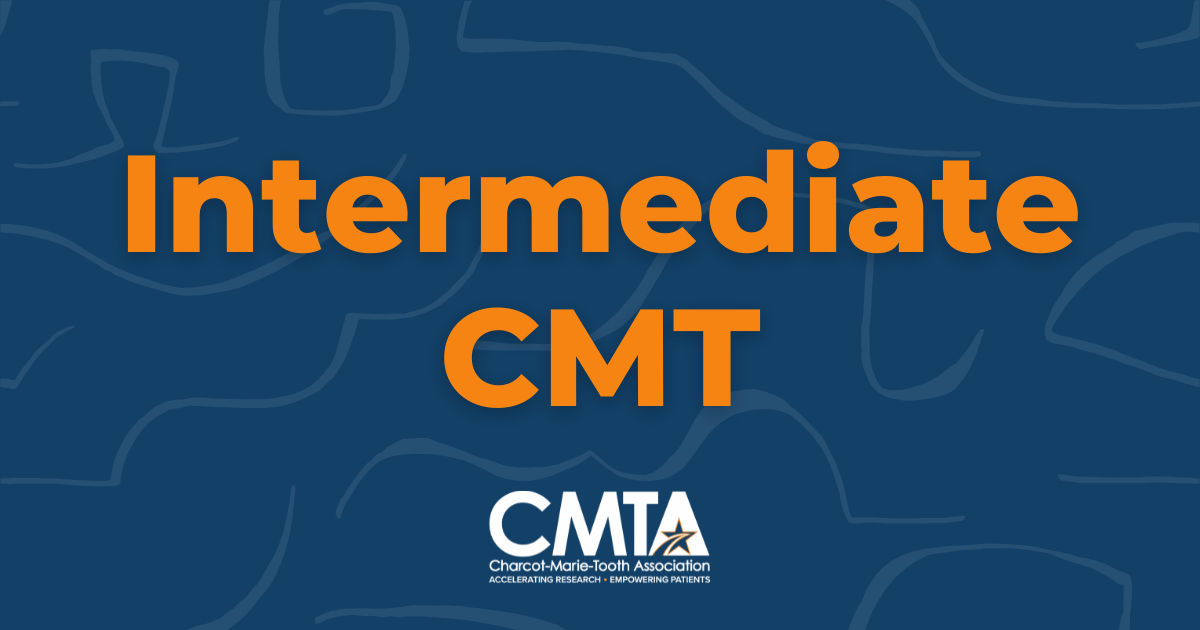
What is Intermediate CMT?
Charcot-Marie-Tooth disease, or CMT for short, is divided into three basic groups of neuropathy: demyelinating (CMT1), axonal (CMT2), and intermediate. Clinically, these three are each determined by nerve conduction study (NCS) results. Nerve conduction study results that show speeds slower than 38 meters/second, and usually slower than 25 meters/second, indicate demyelinating CMT, or what is CMT1; if faster than 38 meters/second, axonal CMT, or what is CMT2; and if NCS results are somewhere in between, intermediate CMT. Intermediate CMT refers only to nerve conduction and not to disease severity or progression. There are currently ten Intermediate CMT subtypes and they are classified into two categories according to their inheritance pattern: dominant or recessive.
What is Dominant Intermediate CMT?
Dominant Intermediate CMT, written as CMT-DI or CMTDI, is a group of six CMT subtypes that are intermediate as determined by nerve conduction study results and are each autosomal dominant in inheritance. Autosomal dominant means the gene with the CMT-causing mutation lives on a numbered chromosome (1-22, the autosomes), and the gene has just one mutation (dominant).
What is Recessive Intermediate CMT?
Recessive Intermediate CMT, written as CMT-RI or CMTRI, is a group of four CMT subtypes that are intermediate as determined by nerve conduction study results and are each autosomal recessive in inheritance. Autosomal recessive means the gene with the CMT-causing mutation lives on a numbered chromosome (1-22, the autosomes), and the gene has two mutations (recessive).
What causes Intermediate CMT
The Intermediate CMT subtypes are each represented by a letter that follows the respective classification, and each are caused by mutations in different genes.
CMTDI Subtypes:
- CMTDIB is caused by an autosomal dominant mutation in the DNM2 gene
- CMTDIC is caused by an autosomal dominant mutation in the YARS1 gene
- CMTDID is caused by an autosomal dominant mutation in the MPZ gene
- CMTDIE is caused by an autosomal dominant mutation in the INF2 gene
- CMTDIF is caused by an autosomal dominant mutation in the GNB4 gene
- CMTDIG is caused by an autosomal dominant mutation in the NEFL gene
CMTRI Subtypes:
- CMTRIA is caused by an autosomal recessive mutation in the GDAP1 gene
- CMTRIB is caused by an autosomal recessive mutation in the KARS1 gene
- CMTRIC is caused by an autosomal recessive mutation in the PLEKHG5 gene
- CMTRID is caused by an autosomal recessive mutation in the COX6A1 gene
What are the symptoms of Intermediate CMT?
The symptoms of Intermediate CMT are not unlike the many other CMT subtypes. Symptoms can vary widely, as can symptom severity, progression, and age of onset. Intermediate refers to nerve conduction study results and not to disease severity or progression.
Symptoms Include but May Not Be Limited To:
- Progressive muscle weakness and atrophy (especially in the feet, lower legs, and hands)
- Drop foot (also called foot drop)
- Gait disturbances (due to foot deformities, ankle instability, foot drop, etc.)
- Absent deep-tendon reflexes (areflexia)
- Loss of sensation and numbness in affected areas
- Structural foot deformities (high arches, hammer toes, etc.)
- Achilles tendon contractures (shortening/tightening of the tendon)
- Finger contractures
- Muscle cramping
- Toe-walking
- Respiratory Impairment
Although each of these symptoms can be present, there is no way to predict if each will, the degree to which they will, nor the progression of any symptom.
When do the symptoms of Intermediate CMT start?
Like the other CMT subtypes, Intermediate CMT symptom onset is quite wide-ranging from early childhood to one’s fifties or sixties. The age at which symptoms are first noticed does not determine disease progression nor overall disease severity.
Special considerations for Intermediate CMT
Dominant Intermediate CMT A, or what is CMTDIA, was originally discovered and named in October 2001 when scientists narrowed the cause for this subtype to a tiny segment of chromosome 10, specifically, 10q24.1-10q25.1. The exact gene, however, remained elusive. In September 2020, scientists discovered autosomal dominant mutations in the GBF1 gene that cause an axonal CMT. Upon review, scientists discovered CMTers diagnosed with CMTDIA each had a mutation in the GBF1 gene, and in October 2021, CMTDIA was reclassified as CMT2GG.
There isn’t necessarily any one symptom or set of symptoms that are unique to any one CMT subtype, with two exceptions: SORD-deficiency CMT and Dominant Intermediate CMT E, or what is CMTDIE, and sometimes referred to as INF2-associated CMT. SORD-deficiency CMT is the only CMT subtype that includes elevated sorbitol levels. CMTDIE is the only CMT subtype that can include a very serious and specific kidney disease.
CMTDIE is caused by any one of many different autosomal dominant mutations in the INF2 gene. Some of these same mutations in this gene also have linkage to a severe kidney disease called Focal Segmental Glomerulosclerosis, or FSGS for short. A hallmark of FSGS is protein in the urine, or what is called proteinuria. Not every CMTer who has CMTDIE will develop symptoms of FSGS (CMT does not cause FSGS) and not everybody who has FSGS will develop CMT symptoms (FSGS does not cause CMT). The specific INF2 gene mutation is the determining factor. If you are diagnosed with CMTDIE, CMT experts recommend regular testing for proteinuria and follow-up with a kidney specialist should urine protein become elevated. For more information about FSGS, visit the National Kidney Foundation.





